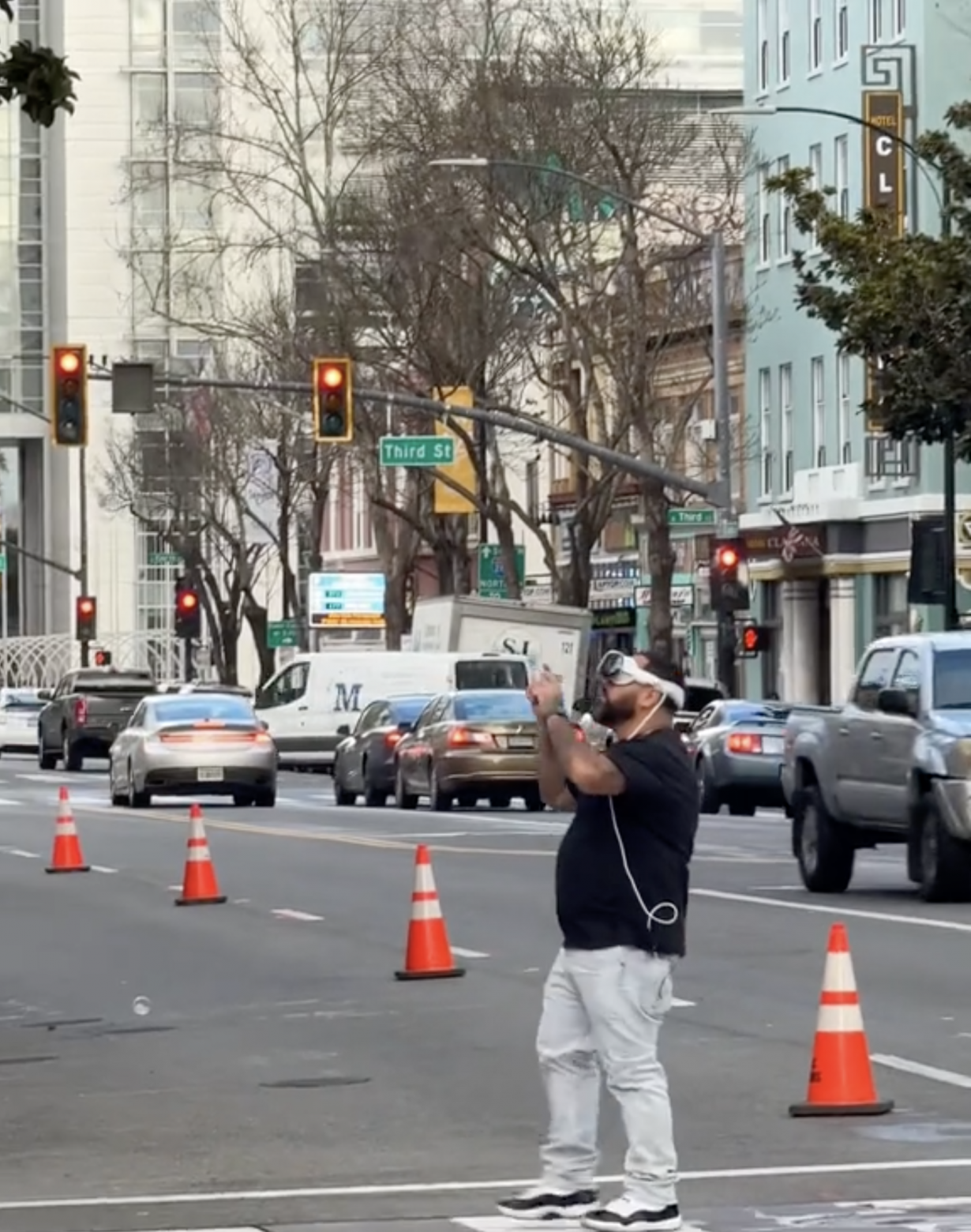The much-hyped ‘mixed reality’ device is a newly invasive means of capturing our attention, the purest expression of the world as a ‘one-person space’
A familiar scene: on 2 February, Apple CEO Tim Cook stood outside the company’s flagship store on Fifth Avenue, New York, surrounded by hollering employees and tech fanboys. They were there for the launch of Apple’s so-called ‘spatial computer’, the Vision Pro, not a laptop or phone but a conspicuously shiny set of goggles with a decidedly workmanlike name.
This computer looks like a virtual reality headset but actually offers mixed or augmented reality. Strap it to your face and, as if by some techno-wizarding magic, a digital interface is laid over what appears to be the ‘real world’, beaming Apple’s suite of apps into your eyes at the outrageously crisp resolution of 3660 x 3200 pixels (per retina!) and a 100hz refresh rate. But it’s not really magic. The mixed reality blend is achieved through a complex set of computations which can be boiled down as thus: using 14 cameras (facing both outwards and inwards), the Vision Pro generates a video feed of the real world which is then passed to the user, on top of which it places 2D displays. You’re not seeing the environment directly – you’re seeing an image – but you think you are, such is the speed of rendering taking place.
Predictably, the Vision Pro’s curious appeal can be summed up by two TikToks. There’s one which takes place in first-person, showing a home augmented with the computer’s teeming ecosystem of screens, the ostensible profundity of the Minority Report-esque scene emphasised by the winsome Hans Zimmer-style strings playing in the background. Then there’s a third-person POV video, a more slapstick affair in which a bespectacled Vision Pro user is shown crossing the road. They are gawked at and mocked while they tweak the size of the window for whatever it is that they’re looking at within the reflective goggles, pinching and groping at thin air.

These are the two seemingly oppositional sides of the Vision Pro: interior and exterior, the user’s perception and how they are perceived. In his history of Japanese virtual reality, media scholar Paul Roquet describes VR as a ‘perceptual enclosure’, drawing a line between these headset technologies and the agricultural movement in England stemming from the 1600s that saw common lands ‘enclosed’ for private landlords. Where previous VR models place you in an entirely new virtual environment, closing off the real world in a manner that is admirably upfront, the Vision Pro is more insidious about public space: you still physically inhabit it but less so – the world entirely refocused around a new, computer-oriented perception. If everyone were to wear these goggles, our public spaces (or what remains of them in an increasingly privatised world) would be degraded to little more than a forum for those who occupy what Roquet calls a ‘one-person space’, the greatest bulk of conversations happening between individuals and their OS.
Those happy to part with the Vision Pro’s $3,500 price tag receive infinitely customisable opportunities to further professionalise, bureaucratise and optimise their everyday lives. This professionalisation of living reminds me of a passage from Don Delillo’s novel Underworld (1997), in which a character, edging towards retirement, laments the demise of their office life. ‘It’s all about the enfolding drone of the computers and fax machines,’ they muse. ‘It’s about the cell phones slotted in the desk chargers, the voice mail and e-mail – a sense of order and command reinforced by the office itself.’ The Vision Pro will likely feel as if it provides the ‘order and command’ of the office while simultaneously delivering, and then some, on its ‘enfolding drone’. Apps and computer programs, already ubiquitous in modern life, become part of the ocular atmosphere, literally encircling the user within the light-speed transmission of information.

The technical complexity of the device itself, and the new mixed reality that users are seeing, is obscured, in typical Apple fashion, by the Vision Pro’s sleek exterior aesthetics. Sure, it resembles a pair of ski goggles (perhaps a boon for the target audience), but the glinting reflectiveness hints at the perceived latent desire of the user to go unnoticed while flaunting their bleeding-edge tech. It’s a little bit like the mirrored homes in the TV show The Curse (2023) whose façades – an attempt by clueless home reno show hosts, Whitney and Asher Siegel (Emma Stone and Nathan Fielder), to create environmentally passive homes – only make them more conspicuous targets of ridicule.
But the two sides of the Vision Pro – the busyness, noise and endless drop-down menus of the interior purview; the smoothness of the exterior – are not antithetical to one another. Through both, the device seems to promise a kind of disappearing act from one realm into another. But surely disappearing in this way implies emancipation? What awaits the Vision Pro user? A new spatial frontier of screens within screens beaming newly intensified versions of work and play into already worn-out, over-stimulated eyeballs. By targeting this part of the body, the device is another step towards a kind of corporeal colonisation by a tech company that has already sold us biometric watches (Apple Watch) and headphones that rebalance our aural surroundings (AirPods). It’s also a literal manifestation of the fight for our attention. With the Vision Pro strapped on, it’s impossible to look away.
Lewis Gordon is a UK-based writer on technology and culture. His writing has appeared in New York Magazine, The Verge and The Nation, among others.
